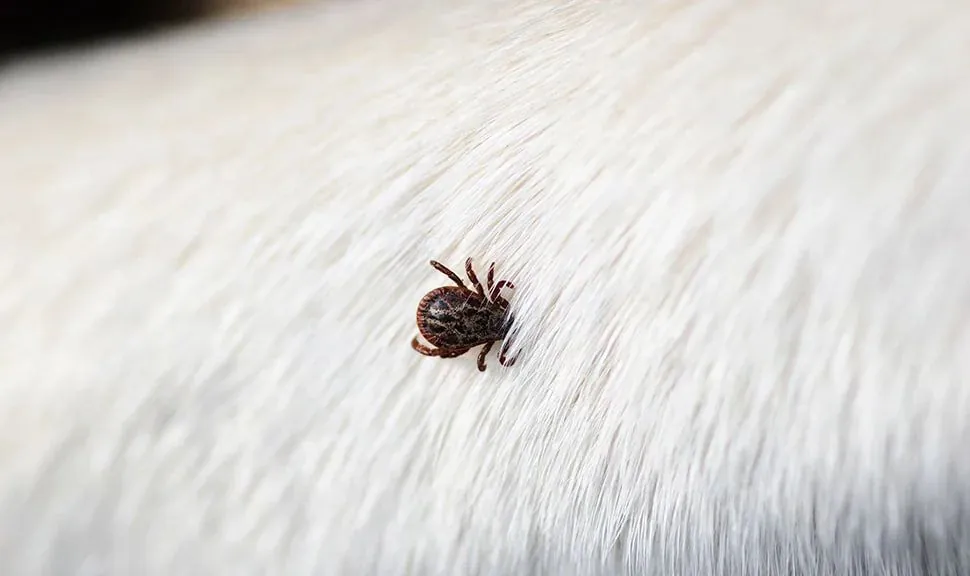Tick season: veterinarian gave advice on how to protect pets 9 March 2025
Kyiv • UNN
The expert spoke about various methods of protecting animals from ticks and their effectiveness. Advice was given on the proper use of drops, tablets, sprays, and collars, as well as instructions for removing ticks.

With the onset of warm weather in Ukraine, the danger of ticks to pets increases. Veterinarian Eduard Kotlyarov told UNN how to protect animals and what to do in case of a tick bite.
Details
To protect an animal from tick bites, or even if not bites, then from infection with tick-borne diseases, it must be treated. The first and most popular, probably what everyone knows, are indeed drops on the withers. They are applied to the skin and all of them are effective for up to four weeks. What is important is that it's not a month, not three, but up to four weeks. Then there is also the tablet form. It probably gained popularity here a little later than drops. Then there is also the spray form, which is also quite popular. There is also the collar form, which is used more for dogs than cats.
He notes that tick tablets have much less variety than drops. According to him, the effectiveness of tick preparations is determined by the correctness of their application.

Because even good quality preparations that could be quite effective, if used incorrectly, people often then consider them ineffective. And so, this is a distorted experience. Then very often they think that this is bad, this is good. So, if you compare the effectiveness between drops, for example, and the same tablets, there is no such thing as drops being more effective or tablets being more effective. Firstly, tablets have different active ingredients, and drops also have different active ingredients. And if you use them correctly, know the nuances of those very drops, then they will be just as effective as tablets.
According to him, it is sometimes believed that tablets are more effective because they are simply a little easier to use, because drops have nuances that certain substances are not active for all four weeks, but for two weeks. The veterinarian notes that the effect of drops can be "destroyed" by the sun, temperature, or if the dog was wet, got caught in the rain, etc., then for a certain time it will be unprotected, because "these drops are washed off the surface of the body and they need to be produced again through the glands on the skin."
Collars will also be great, effective, but if worn correctly, if worn close so that they rub against the skin. If they just dangle on top of the fur, and the fur is something like, for example, a husky, malamute, something like that, then it will have zero effectiveness, because it has to rub against the skin.
He emphasizes that for long-haired dogs, if collars are planned to be used against ticks, it is necessary to shave a strip on the neck where the collar is planned to be worn so that it rubs against the skin.
A man who tortured a dog in front of a child will be tried in Kyiv03.03.25, 13:16 • 26895 views
Sprays, they will also be effective, but you need to know how to apply them correctly, in what quantity, not just spray from a distance, like women hairspray, for example, but you need to apply them specifically against the direction of the hair, do it with a certain frequency of pressing on the body surface.
The doctor notes that during the period of tick activity, it is recommended to combine preparations for animals.
If you combine drops, for example, with the same tablets, it will be great. You can combine everything with tablets and absolutely not worry, because the active ingredients will not overlap. But if, for example, you combine a spray and a collar or a collar and drops, then there will be active ingredients that can overlap.
What are the dangers of tick bites?
According to him, tick bites are dangerous mainly due to infections.
In dogs, this is mainly babesiosis - what most often affects the blood, borreliosis or Lyme disease - what affects both joints and internal organs. (...) For cats, in principle, ticks are also dangerous, although cats are less likely to suffer from these vector-borne diseases from ticks, much less often than dogs, they are less susceptible to this, less sensitive to this. Well, plus small, if it's a small animal, a kitten or a puppy, many ticks will bite it... one tick can drink up to a milliliter of blood, so, roughly speaking, they can drink all its blood, it can die from anemia.
Lukashenka's dog barked at a polling station in Belarus26.01.25, 12:05 • 154461 view
How to remove a tick yourself
In principle, if a person is confident that they can do it (remove the tick themselves - ed.), then it can be done. Nothing critical will happen. In principle, if a person is confident, they want to do it, they can do it themselves, if they cannot seek help from a veterinarian. I immediately say that pouring oil on it or something else does not work, because the tick... people think that if they pour oil on it, the tick will start to suffocate, take it and fall off. No, that won't happen. It gets oxygen from the blood it drinks. It doesn't care at all what is poured on it. It doesn't breathe through the hole it made, but it gets everything it needs inside when its head is in the vessel and it drinks blood there. Therefore, there is no point in smearing it with anything. The tick must be removed mechanically.
The Kyiv Zoo has started to open summer enclosures07.03.25, 13:50 • 19239 views
According to him, a tick can be removed independently with special tweezers, but it is necessary that they are not sharp, because this can be dangerous.

It is better to remove the tick as soon as possible, because some diseases are transmitted when the tick is attached to the body for a certain time, a certain number of hours. That is, if it is pulled out earlier, it will not transmit this infection. Therefore, it is desirable to remove it as soon as possible, if possible. The only unpleasant thing is if the head remains, then purely theoretically it will stay there longer, because it is already harder to get it out from there, and from it this infection can be transmitted, because it transmits the infection through the salivary glands. Usually how? They try to get the tick out, tear off its back, the front remains, and then this front stays until they get to the veterinarian. For example, when at the dacha. This can be in three days, and in three days this infection can be transmitted from the tick to the animal.
You can remove a tick from an animal by prying it with tweezers or twisting it.
Rare humpback whale rescued from fishing net in the Baltic Sea26.02.25, 19:09 • 160843 views